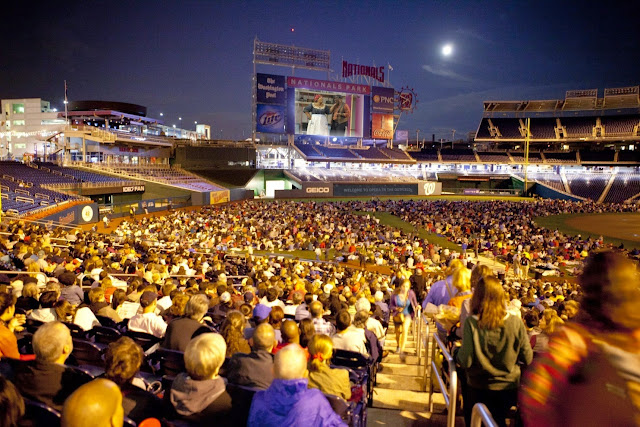The media photos of women in polka-dot kimonos against a bright orange or magenta background betray little of the magic they produce when combined with all other stage effects. In the picture below, the characters may look like a group of hausfrauen in schlafrocks, parodying a Japanese party at a parlor game, but on the stage these costumes are integral parts of pictures that bring to mind the art of Alma Thomas.
The kimono-clad women floated up and down a ramp, that symbolized a hill with Cio Cio San's house on top, in a perfect geometrical order with ringed parasols hovering over their heads like different-color halos. With matching-hued ribbons streaming behind, and brightly lit stage, they were a sight to behold. The dazzling flow of visions, ranging from cheerful to dark and dramatic, became a moving art exhibition, enhanced by drama and sound. Occasionally, video projections, although abstract, suggested the passage of time or the power of the emotion.
Japanese artist Jun Kaneko (who lives in Omaha, Nebraska) has produced this marvel in close collaboration with lighting designer Gary Marder, choreographer Adam Noble and many others involved in the project. The result is sensational. Kaneko says in his production notes that Madama Butterfly has been "one of the most difficult challenges and one of the most exciting creative experiences" in his life. He passed the test with flying colors, literally.
The performers cooperated with his artistic vision and worked well as an ensemble. Ermonela Jaho's passionate portrayal of the unfortunate girl-turned-woman garnered enthusiastic response from the audience. Jagde's physical and vocal size added to her projection of vulnerability. In looks and voices they were well matched and convincing: Jagde as a robust American sailor and Jaho as a dainty Japanese doll. Although a little rough around the edges, Jagde softened in the right places of the powerful Act I duet. And his rendition of Addio, fiorito asil was sensitive and appealing. I will be looking forward to this tenor's next endeavor.
In this production, Pinkerton does not rush on the stage in the final act to sob over Cio Cio San's dead body, but rather calls her name from behind the curtain. Good idea! That scene can otherwise be as embarrassing to watch as, I am sure, it must be to perform.
Kristen Choi is an experienced Suzuki and it was obvious on Saturday. For those of us who had not heard of her before, she was a pleasant surprise. I am glad her Suzuki was able to express love and concern for her mistress without being syrupy. Choi is another singer I'd like to hear again. So is Michael Adams who gave us such a charming Yamadori that one wondered why Butterfly did not get over the braggart who had left her in dire straits, and moved on with the rich guy.
Troy Cook's Sharpless was somewhat disappointing as was Ian McEuen's Goro. Although secondary roles, these can stand out in the hands of masterful performers.
The orchestra under Philippe Auguin's direction excelled again on Saturday. He is becoming one of my favorite conductors.
The highly stylized WNO's production of an operatic staple is an example of how Madama Butterfly, perhaps my least favorite opera, can be moved from the traditionally kitschy milieu into a powerful and unforgettable work of art. Chapeau to WNO's artistic director Francesca Zambello for the strong finale of a season that also gave us Jake Heggie's Dead Man Walking. Perhaps not as memorable as the previous one, but who can beat a line-up with Wagner's Ring in it, and such a magnificent one at that.



















